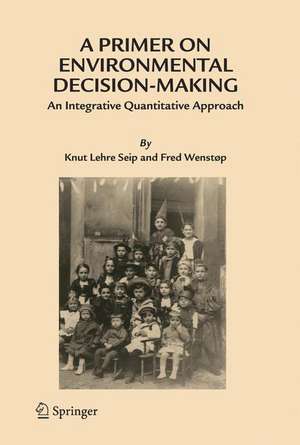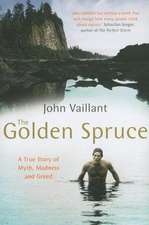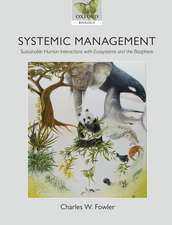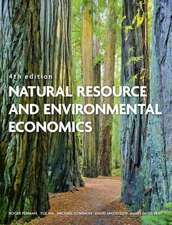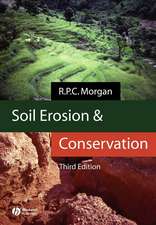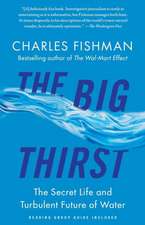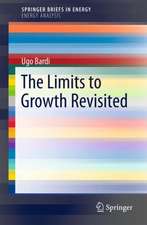A Primer on Environmental Decision-Making: An Integrative Quantitative Approach
Autor Knut Lehre Seip, Fred Wenstøpen Limba Engleză Hardback – 12 oct 2006
To make the text comfortable to read, the book is organized in disciplines, but it also includes 13 applications that draw on all subjects in the book, and where cross-references are extensively used. The applications that range from siting of paper mills to wilderness management show how a range of topics in economics, social sciences and ecology are interrelated when decisions have to be made.
The third chapter is called "Getting started". It shows how to carry out a complete environmental screening study in one day, much like the computer manuals that get you going from the first day. We believe that raising a platform for environmental decision-making puts issues into their right perspective, it is fun, and it lets an individual contribute to society’s understanding of the environment in a very short while.
| Toate formatele și edițiile | Preț | Express |
|---|---|---|
| Paperback (1) | 736.64 lei 6-8 săpt. | |
| SPRINGER NETHERLANDS – 10 noi 2010 | 736.64 lei 6-8 săpt. | |
| Hardback (1) | 1019.79 lei 6-8 săpt. | |
| SPRINGER NETHERLANDS – 12 oct 2006 | 1019.79 lei 6-8 săpt. |
Preț: 1019.79 lei
Preț vechi: 1243.65 lei
-18% Nou
Puncte Express: 1530
Preț estimativ în valută:
195.14€ • 208.67$ • 162.70£
195.14€ • 208.67$ • 162.70£
Carte tipărită la comandă
Livrare economică 17 aprilie-01 mai
Preluare comenzi: 021 569.72.76
Specificații
ISBN-13: 9781402040733
ISBN-10: 1402040733
Pagini: 508
Ilustrații: X, 496 p.
Dimensiuni: 155 x 235 x 24 mm
Greutate: 1.02 kg
Ediția:2006
Editura: SPRINGER NETHERLANDS
Colecția Springer
Locul publicării:Dordrecht, Netherlands
ISBN-10: 1402040733
Pagini: 508
Ilustrații: X, 496 p.
Dimensiuni: 155 x 235 x 24 mm
Greutate: 1.02 kg
Ediția:2006
Editura: SPRINGER NETHERLANDS
Colecția Springer
Locul publicării:Dordrecht, Netherlands
Public țintă
GraduateCuprins
From the contents
Preface.- Part 1 Environmental Decision-Making.- Part 2 The Subjective Experience.- Part 3 Ecological Principles and Processes.- Part 4 The Natural Environment.- Index.
Preface.- Part 1 Environmental Decision-Making.- Part 2 The Subjective Experience.- Part 3 Ecological Principles and Processes.- Part 4 The Natural Environment.- Index.
Recenzii
The book would be valued by academics, bureaucrats and students. The coverage is broad and relevant to the topic it purports to encompass. It is far reaching and much of the theory it addresses is cutting edge. There are a number of emergent disciplines and ideas in this field, and the manner in which this book is structured and composed should enable penetration of al relevant and cognate disciplines. I believe the book is "State- of- the art".
-- Professor Sarah Lumley; University of Western Australia.
I had a pleasure to host Prof. Seip twice at the Institute of Environmental Sciences, Jagiellonian University in Kraków, Poland. Together with his colleague, Dr Reidar Kvadsheim, he provided us excellent courses in applied environmental decision making. The courses were well suited mostly for M.Sc. and Ph.D. students specializing in ecology and environmental sciences. Unfortunately, until now there was no single good source, such as a handbook, that might be used for developing similar courses independently. Thus, I was indeed happy to hear that a primer based on well-established courses in applied environmental decision making is going to be published by Springer.
The one thing I noted after looking through the manuscript of the primer is that it is going to serve a really broad audience: starting from ecologists – with good background in biology and environmental sciences but usually purely prepared to undertake decisions considering also economic and social criteria – to decision-makers, whose education is just opposite – with relatively good insight into economic and social matters, they usually have no or pure education in biology and ecology. Applied environmental decision making is a difficult task, requiring balancing costs and benefits, and both these aspects should be well based on current knowledge. However, while knowledge suffice as the scientific criterion, environmental decision making has to consideralso social costs and preferences. The combination of these both aspects is exactly what our students were taught during the courses provided at the Jagiellonian University, and what is the topic of the primer.
What is very important in the case of this particular handbook is how the authors are able to introduce the two quite different groups of people – the decision-makers and the ecologists – to the areas they are not familiar with. In my opinion, the manuscript I had a pleasure to review for the authors, handles this difficult task exceptionally well. It is written with simple, easy to follow language, it is not overloaded with difficult equations (which would most probably discourage many students), and when these are crucial, some examples are given so that a student can easily follow all the calculations. The book is also rich in graphs and other figures that make the text even easier to understand.
In conclusion, I will be indeed happy to see the book in bookstores and libraries, and I believe that it will enable dozens of lecturers to introduce the interesting field of environmental decision making into university curricula either as separate courses or, at least, as parts of other, more general ones. I am also pretty sure that a number of people working currently in the field of conservation biology, environmental protection, ecotoxicology, etc. will be happy to use this book in their daily professional work.
--Ryszard Laskowski, Institute of Environmental Sciences, Jagiellonian University in Kraków, Poland
-- Professor Sarah Lumley; University of Western Australia.
I had a pleasure to host Prof. Seip twice at the Institute of Environmental Sciences, Jagiellonian University in Kraków, Poland. Together with his colleague, Dr Reidar Kvadsheim, he provided us excellent courses in applied environmental decision making. The courses were well suited mostly for M.Sc. and Ph.D. students specializing in ecology and environmental sciences. Unfortunately, until now there was no single good source, such as a handbook, that might be used for developing similar courses independently. Thus, I was indeed happy to hear that a primer based on well-established courses in applied environmental decision making is going to be published by Springer.
The one thing I noted after looking through the manuscript of the primer is that it is going to serve a really broad audience: starting from ecologists – with good background in biology and environmental sciences but usually purely prepared to undertake decisions considering also economic and social criteria – to decision-makers, whose education is just opposite – with relatively good insight into economic and social matters, they usually have no or pure education in biology and ecology. Applied environmental decision making is a difficult task, requiring balancing costs and benefits, and both these aspects should be well based on current knowledge. However, while knowledge suffice as the scientific criterion, environmental decision making has to consideralso social costs and preferences. The combination of these both aspects is exactly what our students were taught during the courses provided at the Jagiellonian University, and what is the topic of the primer.
What is very important in the case of this particular handbook is how the authors are able to introduce the two quite different groups of people – the decision-makers and the ecologists – to the areas they are not familiar with. In my opinion, the manuscript I had a pleasure to review for the authors, handles this difficult task exceptionally well. It is written with simple, easy to follow language, it is not overloaded with difficult equations (which would most probably discourage many students), and when these are crucial, some examples are given so that a student can easily follow all the calculations. The book is also rich in graphs and other figures that make the text even easier to understand.
In conclusion, I will be indeed happy to see the book in bookstores and libraries, and I believe that it will enable dozens of lecturers to introduce the interesting field of environmental decision making into university curricula either as separate courses or, at least, as parts of other, more general ones. I am also pretty sure that a number of people working currently in the field of conservation biology, environmental protection, ecotoxicology, etc. will be happy to use this book in their daily professional work.
--Ryszard Laskowski, Institute of Environmental Sciences, Jagiellonian University in Kraków, Poland
Textul de pe ultima copertă
This book integrates decision-making and environmental science. For ecologists it will bridge the gap to economics. For practitioners in environmental economics and management it will be a major reference book. It probably contains the largest collection available of expressions and basic equations that are used in environmental sciences. Applying these expressions as "rules-of-thumb" will give participants in a decision-making process a common platform for discussion and arbitration.
To make the text comfortable to read, the book is organized in disciplines, but it also includes 13 applications that draw on all subjects in the book, and where cross-references are extensively used. The applications that range from siting of paper mills to wilderness management show how a range of topics in economics, social sciences and ecology are interrelated when decisions have to be made.
The third chapter is called "Getting started". It shows how to carry out a complete environmental screening study in one day, much like the computer manuals that get you going from the first day. We believe that raising a platform for environmental decision-making puts issues into their right perspective, it is fun, and it lets an individual contribute to society’s understanding of the environment in a very short while.
To make the text comfortable to read, the book is organized in disciplines, but it also includes 13 applications that draw on all subjects in the book, and where cross-references are extensively used. The applications that range from siting of paper mills to wilderness management show how a range of topics in economics, social sciences and ecology are interrelated when decisions have to be made.
The third chapter is called "Getting started". It shows how to carry out a complete environmental screening study in one day, much like the computer manuals that get you going from the first day. We believe that raising a platform for environmental decision-making puts issues into their right perspective, it is fun, and it lets an individual contribute to society’s understanding of the environment in a very short while.
Caracteristici
This book bridges the gap between environmental management and economics. Both themes are treated with equal concern and insight, since all chapters are written in tandem by an ecologist and an economist. The book supports problem based learning and is excellent for project work. It is easy to follow the main steps in a formal decision analysis, and easy to find the material that is needed to support the analyses. The book probably offers the largest existing collection of basic equations related to environmental management. The book highlights the distinction between facts (beliefs) and preferences and shows how they come together in a decision-making process. As far as we know this is the first book on environmental decision analysis that includes chapters on ethics, aesthetics as well as life quality. By including these chapters, difficult issues that belong to the subjective environment become embedded in real decision situations.
